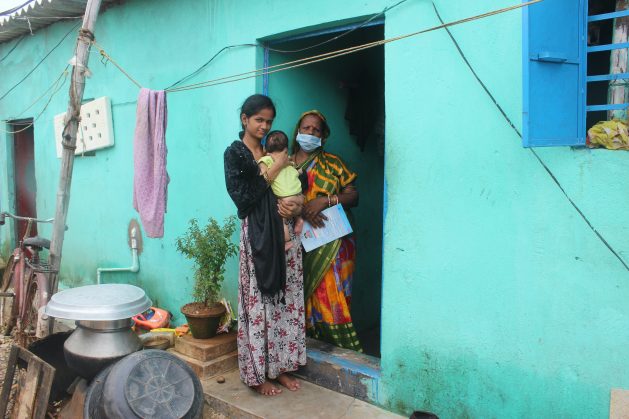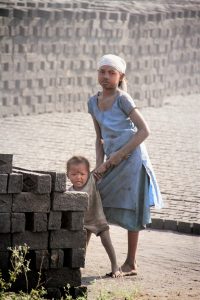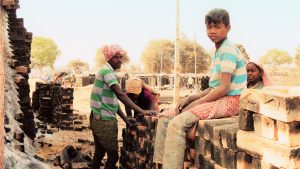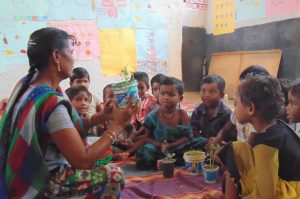As Climate Disaster Migration Rises, Girls Get Married Off

BHUBANESWAR, India, Aug 25 (IPS) - When 11-year-old Mitali Padhi hugged her childhood friends to say goodbye, she felt a deep-seated foreboding.
Around her, the mud walls of their home had collapsed, wrecking their meagre belongings. All were mired in mud. The straw roof lay splayed 100 metres away from the house – blown away by tropical storm Phailin.
The tropical storm made landfall at 136 mph wind speeds near Mitali’s village in India’s eastern coastal Odisha State. The storm left 3.7 million houses damaged in its wake.
However pitiable this mud hut, it was the only secure place the girl had ever known, and it was a place where, since birth, a larger community supported her.
Rice paddies had turned into sea-water pools. Mitali’s father, a farm labourer, would have no work for a year until monsoons washed away the salt from farmlands.
Her family of five, her parents and two elder brothers, took a high-interest local loan and migrated to the nearest urban centre Bhubaneswar. This was 2013.
When IPS met Mitali Padhi, she had a 3-month-old baby boy in her arms. The frail 19-year-old says she is breastfeeding but feels extremely weak.
“We got a protein drink for her (Mitali), but she dislikes it,” her Mitali’s mother, Pravati Padhi, 50, interjects.
We stand between two parallel rows of one-room brick and asbestos hutments that the Padhi family built and moved into after super cyclone Fani in 2019. This cyclone, described as the worst since 1999, decimated their tiny mud-walled, plastic-sheet covered hut that squatted illegally against a university’s compound wall – displacing the family for a second time.
Mitali’s father runs a 3-wheeler tuk-tuk but is “lazy, moody, and his earnings are erratic,” according to his wife, Pravati. After leaving their village in 2013, the burden of providing for her three children was on her, she tells IPS. Since then, she sells spicy snacks on roadsides earning $10 a day.
After migrating to the city, the 11-year Mitali looked after the cooking for the family. After lunch, she helped her mother roll out tiny puffed poori (bread) and fry them crisp while her mother prepared the boiled potato filling and spicy, tangy water for the popular snacks.
In a dire financial state once again after the 2019 cyclone, Pravati decided to marry off Mitali. It would mean one less mouth to feed, “and the young man was earning well.”
“We were eating out our savings after the storm. My daughter was already ‘mature,’ (reached puberty), she was not in school, and when I was away from home vending, and she was alone, young boys from our slum tried to chat her up, come into the house,” Mitali’s mother told IPS, justifying the marriage of her teenage daughter.
Soon Mitali was pregnant – at barely 18.
“I would have liked to learn sewing, earn and get married only when I was 22,” she tells IPS.

The family are an example of increasingly vulnerable people affected by climate change disasters.
“As (the number of) climate disasters rise in Odisha, drought (is experienced) in its western part, cyclones in the coastal region, floods in over half of its 30 provinces,” Ghasiram Panda, Programme Manager for ActionAid, told IPS. “Because of poverty, because of their vulnerability, there are concerns for the safety (of vulnerable communities). We are seeing an increasing trend of girls being married off before the age of 18.”
This is not only in the rural areas.
“In Bhubaneswar city slums, populated by rural migrants in search of livelihoods, child marriages are (also) on the rise,” Ghasiram Panda says. “While rural families migrate to cities to better their income, girl children more particularly are unable to access education, they do poorly in school or drop out, and parents think marriage is the best way out.”
Umi Daniel, Director, Migration & Education, Aide et Action, South Asia, says children are adversely affected because “a quarter of all migrating population (from Odisha to brick kilns) are children.”
According to the UN, in India, internal migrants accounted for around 20 percent of the country’s workforce in 2017, which currently equals 100 million people.
Around the world, approximately 1 in 45 children are on the move. Nearly 50 million boys and girls have migrated across borders or forcibly displaced within their own countries, UNICEF estimated in 2017.
Climate-related events and their impacts are already contributing significantly to these staggering numbers, with 14.7 million people facing internal displacement due to weather-related disasters in 2015 alone.
The annual average since 2008 is increasing and now at 21.5 million is equivalent to almost 2 500 people being displaced every day.
Owing to climate change, 27 of the 37 Indian states are now disaster-prone. Some 68 percent of the cultivated land is vulnerable to drought, 58.6 percent landmass is prone to earthquakes, 12 percent to floods, 5,700 km of the coastline is prone to cyclones, and 15 percent of the area is susceptible to landslides, according to India’s National Disaster Management Authority.
“Mitali still is fortunate,” Gitanjali Panda, community mobiliser of local non-profit Centre for Child and Women Development, tells IPS.
Another internal migrant girl, ‘fell in love’ and eloped with a boy when she was 15, Gitanjali Panda says. The infatuation wore off within a year, and the family got her back but hastily married her off to another man.
Gitanjali Panda frequently visits the slum and says the young woman, a mother of a 5-year child at 21, had complained of excruciating stomach pain. She miscarried her second child. The doctor then diagnosed a ‘cracked uterus’ – the result of a fall during her first pregnancy at aged 16.
In Daniel’s experience, children are “invisible entities” – they don’t even count. Always migration in India is seen as male-dominated. The government doesn’t even (acknowledge) families are migrating, let alone formulating pro-child migration policies.”
Daniel has worked on migration and child rights for three decades, heading the Aide et Action’s Migration Information and Resource Centre (MIRC) in Bhubaneswar.

Internally displaced families live in rows of temporary tin huts next to brick kilns in the suburban areas where they congregate. In these tin boxes, without doors and with just a torn sari hanging at the door for privacy, boys may get beaten and made to work inhumanly as bonded labour, but girls are “several times more vulnerable,” Daniel says.
Girls and women face “disproportionate threats to their safety and most basic human rights,” Action Aid’s Ghasiram Panda agrees. They are, too often, “the silent victims of climate disasters.”
Governments rarely consider their specific needs and vulnerabilities, he says.
“Rape is frequent,” Daniel told IPS. MIRC took up a case where three minor girls were raped in front of their parents in a brick kiln by the drunk kiln owner and his friends. They were from Karimnagar in Telangana State, which is a climate migrants’ destination. It took MIRC five to six years in a fast-tracked court to bring the wealthier culprits to justice.
As climate displacement and internal migration increases with more intense natural disasters impacting the poorest, Umi says solutions are being implemented by the non-profit organisations but “urgently need scaling-up by governments.”

Among the hopelessness, there are stories of success. A decade ago, Aide et Action’s Migration Information and Resource Centre started sourcing youth volunteers from India’s migrants’ origin provinces to go to destination locations and teach migrant children in their local dialect at the kiln sites.
Initially, the kiln owners refused to allow these informal learning centres.
“Now owners are putting in money themselves because they see women’s outputs increase when their children, adolescents to infants, are taken care of,” Umi says.
Government schools often agree to allow two rooms for these informal teaching classes. When migrants’ children return home for the four paddy-sowing months of August to November, they can seamlessly continue their schooling.
“In these ten years, we were able to reach out to 30 000 children with this facility. We started with just 250 children,” Umi says.
Ghasiram Panda says, however, there is a lot more that needs doing.
“Strengthening the government system to be more sensitive towards children’s issues, linking (migrant) youth to re-integrate and fully utilise schemes meant for their benefit, is Action Aid’s main focus now.”
This feature was produced on behalf of the German Federal Ministry for Economic Cooperation and Development.
Follow @IPSNewsUNBureau
Follow IPS New UN Bureau on Instagram
© Inter Press Service (2021) — All Rights Reserved. Original source: Inter Press Service
 Global Issues
Global Issues